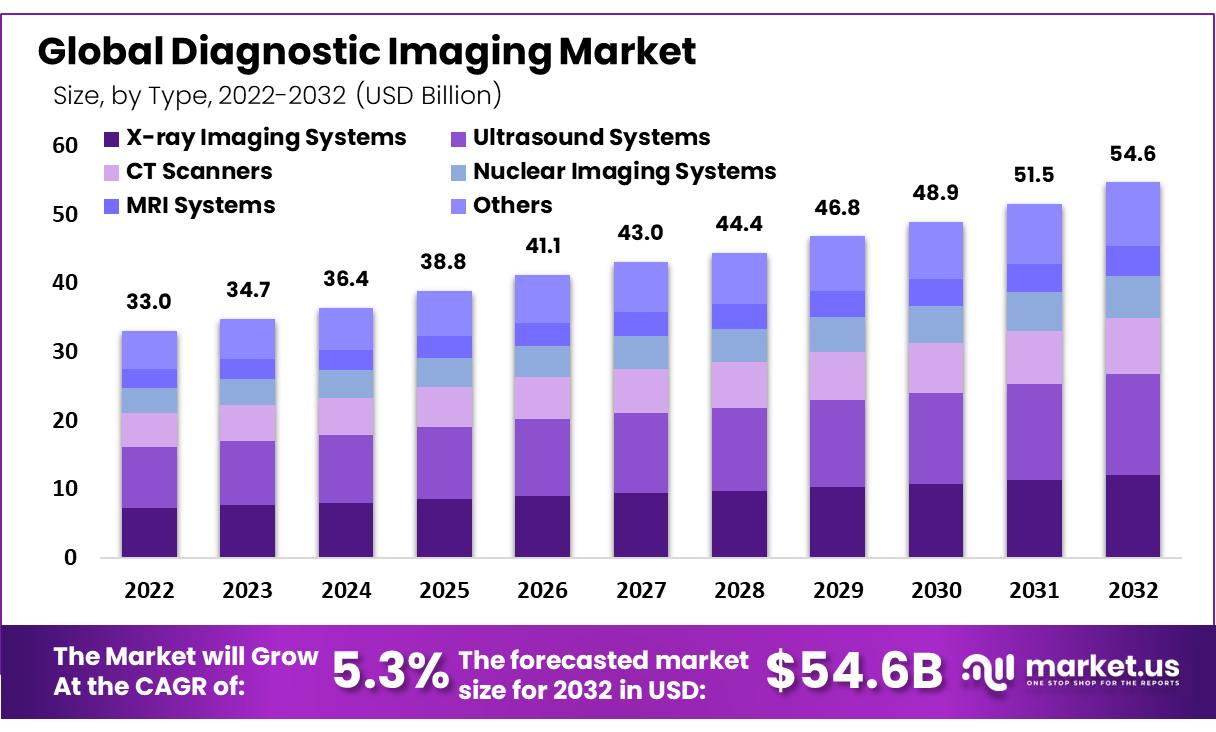Table of Contents
Introduction
The Global Diagnostic Imaging Market, valued at USD 33 billion in 2022, is projected to reach approximately USD 54.6 billion by 2032, with a compound annual growth rate (CAGR) of 5.3% from 2023 to 2032. This growth is primarily driven by the increasing prevalence of chronic diseases among the aging population, necessitating advanced imaging services for effective management and diagnosis.
Technological innovations are significantly enhancing the diagnostic imaging sector. The integration of artificial intelligence (AI) improves the accuracy and efficiency of image analysis, aiding in the diagnosis of complex conditions such as lung nodules. Additionally, the adoption of cutting-edge imaging technologies and equipment, like 3D printing for PET scans, is elevating the quality and precision of diagnostics, enabling more accurate treatments tailored to individual patient needs.
The expansion of telemedicine and the enhancement of regulatory and reimbursement policies further stimulate market growth. Telemedicine facilitates remote diagnostics and broadens access to healthcare services, especially in underserved regions. Meanwhile, advancements in healthcare policies, including better reimbursement practices, support the adoption of new technologies and ensure the financial sustainability of imaging services. These factors collectively contribute to the robust development trajectory of the diagnostic imaging sector, aimed at improving patient care and health outcomes.
Key Takeaways
- In 2022, the global diagnostics imaging market was valued at USD 33 billion, projected to hit USD 54.6 billion by 2032.
- This market’s expected annual growth rate between 2023 and 2032 is approximately 5.3%.
- The ultrasound segment leads the market, boosted by innovations like portable devices and AI integration.
- The CT segment is set to grow fastest, driven by the demand for advanced Point of Care CT devices and AI-enhanced scanners.
- Oncology imaging generates the most revenue, reflecting the global increase in cancer cases and focus on early diagnosis.
- The orthopedics sector will likely grow fastest, supported by an aging population and improved diagnostic tools.
- Hospitals are the primary end-users, benefiting from cutting-edge imaging technologies and modalities.
- Growth in Asia-Pacific is fueled by an increase in private healthcare and new imaging-equipped hospitals.
- Market growth drivers include advanced imaging systems, cost-effective diagnostic solutions, and population increases.
- Innovations like the One-Beat Spectral Cardiac CT are vital for industry growth.
- Market growth is challenged by frequent product recalls and competition from low-cost refurbished equipment.
- Opportunities arise from increased healthcare spending and R&D in emerging countries, alongside new medical imaging modalities.
- Mid-range CT scanners are anticipated to dominate, especially useful in angiography and cardiac studies.
- North America leads the market due to many industry players, favorable reimbursement, and high healthcare investment.
- The fastest growth is expected in the Asia-Pacific region, driven by rising chronic disease rates and demand for advanced imaging tools.
Emerging Trends
- AI Integration in Diagnostic Imaging: Artificial Intelligence (AI) is revolutionizing diagnostic imaging. It automates workflows and enhances the accuracy of diagnostic procedures. AI algorithms are adept at processing large datasets, which empowers healthcare professionals to make well-informed decisions. This technology is particularly transformative in areas like lung nodule identification from CT scans and advanced breast imaging. By integrating AI, the diagnostic field is witnessing significant improvements in both speed and precision of imaging services.
- 3D Printing Technology: The adoption of 3D printing in diagnostic imaging is on the rise. This technology is used to create radioactive phantoms—test objects for calibrating and ensuring the quality of clinical PET scanners. These phantoms mimic human anatomy with high accuracy, which standardizes radioactive measurements across different imaging sites. The precision of 3D-printed phantoms enhances the reliability of diagnostic imaging, leading to better patient outcomes.
- Robotic Automation in Healthcare: Robotics is becoming integral to healthcare, addressing staff shortages and enhancing service efficiency. In diagnostic imaging, robots are used to transport and manage imaging equipment, assisting also in complex surgical operations. This automation not only streamlines operations but also boosts the accuracy and efficiency of diagnostic services, ensuring higher standards of patient care.
- Advancements in Wearable Diagnostic Devices: Wearable technology is advancing rapidly, offering low-cost and high-accuracy devices for continuous health monitoring. These devices are increasingly integrated with diagnostic imaging systems, providing a comprehensive real-time view of a patient’s health. This integration helps in early detection and ongoing monitoring, playing a crucial role in preventive healthcare.
- Expansion of Tele-radiology Services: Tele-radiology is expanding, allowing radiologists to diagnose patients remotely. This trend is especially beneficial in underserved areas, where access to specialized healthcare services is limited. By leveraging digital communication tools, tele-radiology ensures that expert diagnostic services are more accessible, enhancing the reach and impact of healthcare providers worldwide.
Use Cases
- Enhanced Patient Safety Through AI: Artificial Intelligence (AI) is revolutionizing patient safety in diagnostic imaging. By leveraging AI, healthcare providers can predict clinical deteriorations more accurately and detect diseases like cancer earlier. This early detection is critical, as it can significantly improve treatment outcomes and patient recovery rates. AI-driven tools are thus becoming indispensable in the ongoing effort to enhance healthcare quality and patient safety.
- Efficient Data Management in Imaging: Hospitals perform billions of imaging procedures each year, generating vast amounts of data. Traditionally, up to 97% of this imaging data might remain unused. AI is changing this scenario by structuring and indexing such data, making it accessible and usable. This advancement allows for more accurate diagnostics and efficient use of information, thereby optimizing the workflow in medical imaging departments.
- Revenue Cycle Management with AI: AI is streamlining some of the most complex areas of diagnostic imaging, such as reimbursement and compliance. By implementing intelligent automation, healthcare facilities can enhance the accuracy of billing and compliance processes, significantly reducing the time required for these tasks. This improvement in revenue cycle management not only cuts down on administrative costs but also allows medical staff to focus more on patient care.
- Personalized Treatment Plans Enabled by AI: The integration of AI with genomic data is setting the stage for personalized medicine. In diagnostic imaging, combining detailed imaging results with patients’ genetic information enables the creation of tailored treatment plans. This approach enhances the efficacy of treatments by aligning them more closely with the unique genetic profiles of individual patients, thus pushing the boundaries of personalized healthcare.
- Application of Virtual and Augmented Reality in Imaging: Virtual and augmented reality technologies are transforming the educational landscape and the execution of complex surgeries in the medical field. These technologies provide surgeons and medical students with real-time, three-dimensional imaging data. This capability makes surgical procedures and medical training more interactive, precise, and effective, leading to better educational outcomes and surgical accuracy.
Conclusion
The Diagnostic Imaging Market is poised for substantial growth, forecasted to increase from USD 33 billion in 2022 to USD 54.6 billion by 2032. This expansion is driven by the rising need for advanced imaging to manage and diagnose chronic conditions prevalent in the aging population. Technological advancements, particularly the integration of AI and 3D printing, are significantly enhancing the precision and efficiency of diagnostic processes. Moreover, the growth of telemedicine and improved regulatory frameworks are facilitating wider access to innovative imaging solutions, thus improving patient care globally. As the market evolves, the focus on developing accessible, advanced diagnostic tools continues to be a central theme, promising enhanced health outcomes for patients worldwide.
Discuss your needs with our analyst
Please share your requirements with more details so our analyst can check if they can solve your problem(s)



